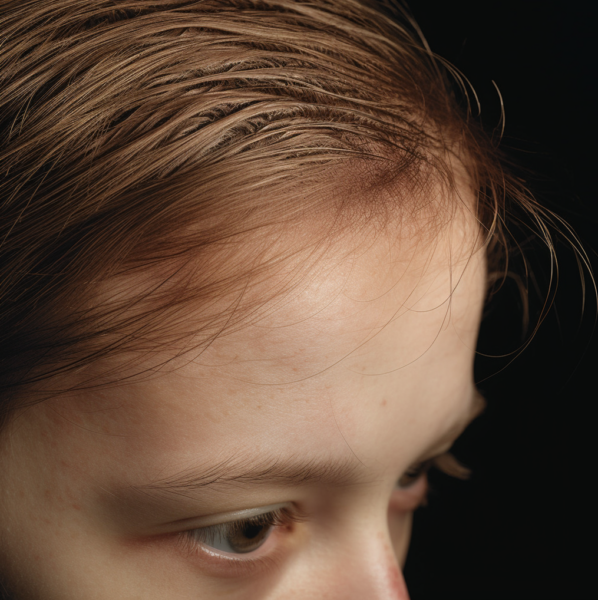Traction alopecia (TA) is a form of hair loss primarily caused by prolonged and excessive tension or pull on the hair follicles. This condition has been independently identified and described numerous times throughout history, often linked to traditional hair styling practices within various cultures.
One of the earliest recorded observations of TA was made by the British explorer James Bruce in 1790, while visiting Sudan. Bruce noted the baldness associated with tightly braided hair among local women, specifically mentioning the Sittina of Shendi, who asked him for medicine to promote hair growth. Bruce suggested her hair loss was likely due to the weight of a gold cap she habitually wore on her head.

A more scientifically oriented account of TA appeared in 1907, by an Austrian dermatologist, Trebitsch, who noticed a unique marginal temporoparietal alopecia among Greenlandic women who wore their hair in traditional tight coiffures. This observation contrasted with the hair health of women wearing looser, European styles. Trebitsch named this condition “alopecia Groenlandica.”
In 1957, Hjorth conducted a study on the same group of Greenlandic people and documented a notable pattern of symmetrical hair loss or thinning that originated at the hairline. This was associated with follicular atrophy and sporadic instances of perifolliculitis. Intriguingly, he observed a distinct feature of the condition; a lingering, thin strip of hair preserved at the outermost edge of the alopecia-affected area. Today this feature is called the “fringe sign” and is one of the diagnostic marks of traction alopecia.
In 1931, Aramaki reported a syndrome of marginal alopecia in Japan, which he attributed to traditional hairstyles of the country, calling it alopecia atrophica symmetrica temporalis. Different regional hairstyles in Japan resulted in various patterns of hair loss.
In the same year, the French dermatologist Sabouraud recognized frontal alopecia among French peasant women and called it alopecia liminaris frontalis. He observed the women wore their hair in tight chignons (hair buns) but surprisingly he did not associate the hair loss with traction. In 1933 Balina, an Argentine dermatologist, was the first to suggest that traction, as well as accompanying inflammation, were responsible for the hair loss in such patients.
In 1937, Sezary and Rabut proposed that hair follicle trauma could lead to a staphylococcal folliculitis. In the same vein, Spencer highlighted that braids that were tightly pulled could be a trigger for traumatic folliculitis. Also during the same year, Ribeiro coined the term “traumatic marginal alopecia,” justified by the characteristic localization of hair loss at the outer edges of the scalp, stemming from its traumatic cause. Later, in 1943, Costa and Jungueira conducted an in-depth review of the available literature and clearly documented a case of traumatic marginal alopecia that affected the full circumference of the scalp and extended significantly into the frontal region. They concluded, based on their clinical findings, that the symptoms of alopecia liminaris frontalis and traumatic marginal alopecia were essentially identical.
The term “traction alopecia” was first used by Slepyan in 1958, establishing a name for this condition that underscored the role of traction as a major precipitating factor. Slepyan also noted that while trauma can cause sudden hair loss, traction alopecia implies a slowly persistent injury leading to inflammation and subsequent hair loss. Later in 1958, Savill associated the emergence of TA with new nylon brush technology and permanent hairstyling techniques among English patients.
Throughout the 20th century and continuing to the present day, TA has been predominantly researched in the context of women of African descent. This emphasis arose due to the common practices of tight braiding and aggressive chemical and thermal hair treatments.
In 1937 and 1938, Ribeiro characterized a condition known as “alopecie marginale traumatique,” which presented as baldness above and in front of the ears, primarily observed in women of African descent, with the potential to spread further. Cases of a similar nature were reported by Casals in 1938 from Cuba, primarily in patients over 40 years old. In 1941, Spencer published a study on four African-American women with bilateral temporal alopecia, all of whom had histories of wearing their hair in very tight braids. Costa and Junqueira, hailing from Brazil, noticed similar cases to those of Ribeiro in 1943. They underscored the role of tightly applied hair curlers used to straighten the naturally coiled texture of hair common among people of African heritage. In 1950, Anderson noted comparable instances in individuals of African descent in America who had used hot metal combs to achieve the same hair straightening effect.
Additional discoveries over the years have deepened our understanding of TA. Rollins made a connection between hair casts—yellowish-white, firm keratin cylinders that move freely along the hair shaft—and traction alopecia in 1961. These hair casts had only been described a few years earlier, in 1957, by Brunner and separately by Kligman in African Americans. Today these hair casts are a key diagnostic sign for traction alopecia.
The traditional hairstyles of Northern Sudan were reported by Morgan in 1960 as causes of TA. Morgan described the regional coiffure practices, comprising many tight plaits, that hang from the middle of the scalp, leading to considerable traction alopecia hair loss among Sudanese women. Interestingly Morgan describes the hair braiding in some detail. He claimed the women of Northern Sudan adhere firmly to their cultural beauty routines, often maintaining a single hairstyle throughout their lifetime (remember this was written in 1960). This traditional hairstyle comprises numerous taut braids, sometimes even exceeding 120 in number, originating from the center of the scalp. A parting, resembling a crown, separates the hair into four sections. Women would often weave black silk thread into these braids to enhance the hair’s natural length, with the locks often reaching as far down as the buttocks. The silk woven into the braids could weigh up to 16 ounces (450 grams) which would increase the strain on the hair. The hair was re-braided every one to three months, a process that typically required around three days to unfasten and re-braid. This hairstyle, likely steeped in ancient tradition, echoes the likeness of Nefert, a statue residing in the Cairo Museum. Belonging to the fourth dynasty of the old Kingdom of Egypt, this over 5000-year-old statue of Nefert also exhibits numerous short, tight braids. This suggests traction alopecia could have existed in ancient times.
TA’s history is intertwined with cultural, aesthetic, and technological changes in hair care practices worldwide. While originally identified within specific ethnic and regional contexts, its impact is universal, leading to considerable research and efforts to educate people about hair care practices that minimize the risk of this type of hair loss. As our understanding of TA has evolved, the emphasis is now on preventive strategies, focusing on healthier hairstyling habits and treatments to mitigate the effects of TA. Other articles on this website describe the modern knowledge and understanding we have of traction alopecia.
Bibliography


